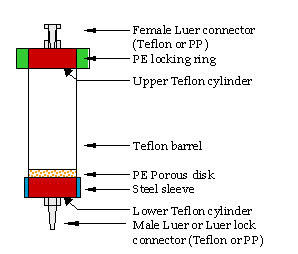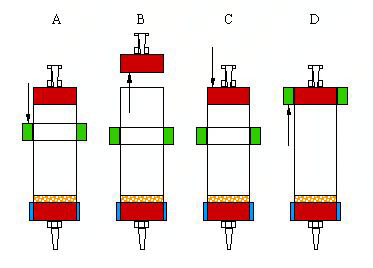|
Teflon vessel for solid-phase synthesis
The Teflon vessel with two inlets/outlets is designed for solid-phase synthesis. The lower Teflon cylinder has an additional opening and a polyethylene porous disk for filtering solid phase support (resin). The lower inlet/outlet is equipped with male Luer connector, the upper opening has female Luer connector. The PE locking ring locks the position of the upper Teflon cylinder, in a similar fashion to the previous reaction vessel. This reaction vessel has been designed to replace the popular polypropylene (PP) syringe. Polypropylene syringes, the simplest reaction vessels for solid-phase synthesis, suffer from one serious drawback. The syringe barrel swells in certain solvents (dichloromethane, tetrahydrofuran, dioxane) and, after several hours of exposure, the syringe plunger does not provide tight seal. This problem is now solved by our new product - the Teflon reaction vessel.
|

|
|
Working with Teflon reaction
vessels
The Teflon vessel is opened and closed the following
way:
1. The PE locking ring is moved downward (panel A)
2. The
upper Teflon cylinder is removed from the Teflon barrel. We recommend
using standard pliers. At this stage the Teflon vessel can be charged,
e.g., with resin for the solid-phase synthesis (panel B).
3. The
upper cylinder is placed back into the Teflon body (panel C).
4. The PE locking ring is moved upward to secure the position of the upper Teflon cylinder during the synthesis (panel D).
|

|
|
Teflon reaction vessels are used for solid phase synthesis in an analogous way to typical polypropylene syringe. The vessels are charged with the resin, solvent used in the following reaction is added to make resin slurry, and the resin is washed with this solvent (typically 1 mL of solvent per 100 mg of resin). To wash the resin, the solvent plus a small amount of air is drawn into the vessel, the vessel is shaken for half minute and solvent is discharged. The most convenient washing and conditioning the resin for solid phase synthesis in number of vessels at the same time (up to 48) is achieved in Domino Blocks. Because of increased weight of Teflon reaction vessels we recommend to use Domino Blocks with a holder.
|
Teflon reaction vessels
for solid-phase synthesis are manufactured in two different sizes. The following Table shows maximum resin loads for individual sizes.
| Vessel
volume
|
Resin
quantity
|
20 mL
|
1 g
|
50 mL
|
3 g
|
|

